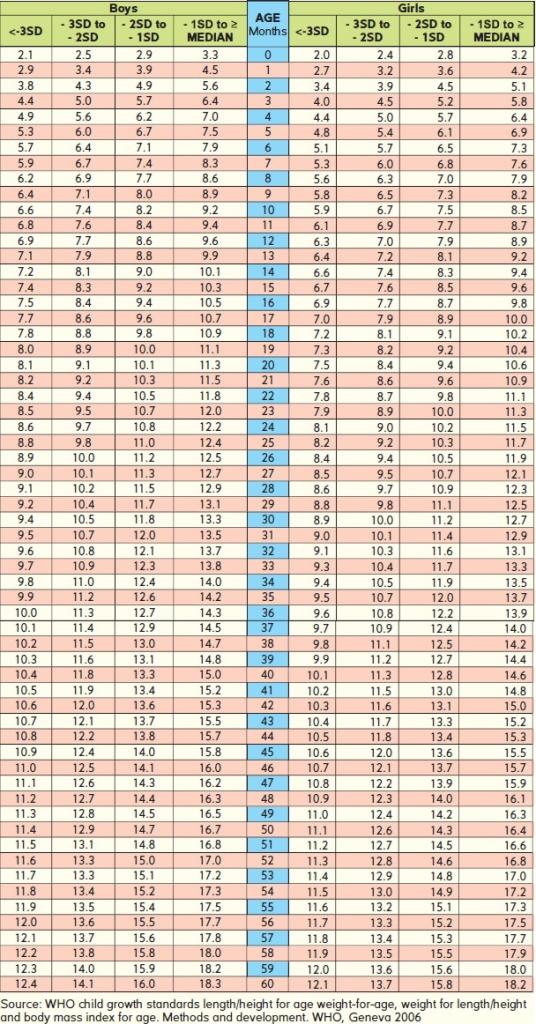Diet for children and adolescents
Diet for children and adolescents
- Ensure adequate and appropriate diets for children and adolescents both in health and sickness
- Why do children and adolescents require more food?
- How do infections in children lead to malnutrition?
- How should a child be fed during illness?
- What should be done during diarrhea?
- How important is the problem of lactose intolerance?
- Eat Calcium-Rich Foods
- During Illness
- WHO New Growth Standards Standard Deviation (SD) Classification: Weight- for-Age
Ensure adequate and appropriate diets for children and adolescents both in health and sickness
Rationale: Well-formulated balanced diets for children and adolescents help optimum growth and boosts their immunity
- A nutritionally adequate and balanced diet is essential for optimal growth and development.
- Appropriate diet and physical activity during childhood is essential for optimum body composition, BMI and to reduce the risk of diet-related chronic diseases in later life and prevent vitamin deficiency.
- Common infections and malnutrition contribute significantly to child morbidity and mortality.
- A child needs to eat more during and after episodes of infections to maintain good nutritional status.
- Take extra care in feeding a young child and include soft cooked vegetables and seasonal fruits.
- Give plenty of milk and milk products to children and adolescents.
- Promote physical activity and appropriate lifestyle practices
- Discourage overeating as well as indiscriminate dieting.
Why do children and adolescents require more food?
Childhood and adolescence are periods of continuous growth and development. An infant grows rapidly, doubling its birth weight by 5 months and tripling it by 1 year of age. During the second year, the child increases not only in height by 7-8 cm but also gains 4 times of its birth weight. During the pre-adolescent period the child grows, on an average, 6-7 cm in height and 1.5 to 3 kg in weight every year and simultaneously development and maturation of various tissues and organs take place.
Adolescent period (teenage) is spread almost over a decade. It is characterized by rapid increase in height and weight, hormonal changes, sexual maturation and wide swings in emotion. Adolescent growth spurt starts at about 10-12 years in girls and two years later in boys. The annual peak rates for height and weight are 9-10 cm and 8-10 kg. Development of critical bone mass is essential during this period as this forms the ground for maintaining mineral integrity of the bone in later life. The pattern and proportion of various body components like body water, muscle mass, bone and fat increase during the entire childhood and adolescence to reach adult values by about 18 years. Adolescent girls are at greater physiological stress than boys because of menstruation. Their nutritional needs are of particular importance as they have to prepare for motherhood. All these rapid anabolic changes require more nutrients per unit body weight.
Growing children and adolescents require more calcium. Though recommended dietary allowances for calcium are about 600-800 mg/day, it is desirable to give higher quantities of calcium for adolescents to achieve high peak bone mass. To achieve optimal peak bone mass, it is recommended to consume calcium rich foods like milk and milk products, fox tail millet (Ragi), til etc.
Young children below the age of 5 years should be given less bulky foods, rich in energy and protein such as legumes, pulses, nuts, edible oil/ghee, sugar, milk and eggs. Vegetables including green leafy vegetables and locally available seasonal fruits should be part of their daily menu. Snacks make a useful contribution to the nutrient requirements, particularly in older children and adolescents. Frequent changes in the menu are often liked by children.
Older children and adolescents should consume plenty of milk to fulfill the high calcium requirements. Cooking oils/ghee (25-50g) should be consumed. Overindulgence in fats may be avoided. Excessive salt intake should be avoided particularly by children having a family history of hypertension. Adolescence is the vulnerable stage for developing wrong food habits as well as bad habits like smoking, chewing tobacco or drinking alcohol. These should be avoided. In addition to consumption of a nutritious well balanced diet, appropriate lifestyle practices and involvement in physical activity such as games/sports should be encouraged among children and adolescents.
How do infections in children lead to malnutrition?
Common childhood infections like diarrhea, measles and pneumonia occur in association with malnutrition and contribute to about 70% of mortality. Appropriate feeding during infection is essential, which demands a lot of patience from the mother.
During periods of infection, children tend to eat less due to reduced appetite. Many children vomit frequently. Nutrients are also lost in urine and faeces. The unhealthy practice of restricting diet, including breast-feeding, by the mother during any sickness could further aggravate the problem. Hence, extra care is needed in feeding the child appropriately during and after illness to prevent subsequent nutritional deficiencies.
How should a child be fed during illness?
Breast-feeds are often well accepted and tolerated even by sick children and should be continued except in severe gastroenteritis associated with shock. For older children, consuming an adult diet, soft cooked food may be offered at frequent intervals. The quantity of the feeds may be increased, after the illness has subsided, till the original weight is regained.
What should be done during diarrhea?
Diarrhea is a common childhood disease which leads to dehydration and sometimes death. The child requires prompt correction of fluid and electrolyte loss using oral rehydration solution (ORS) along with appropriate/adequate feeding. ORS can be prepared by adding a pinch of salt (between thumb and index finger) and a teaspoon of sugar to a glass of potable water. Home-made fluids such as rice kanji or buttermilk with salt can also be used. During infections, children should frequently be given small quantities of fluids by mouth, including plain water. During diarrhea, feeding should be continued, though this goes against the popular practice. Breast-milk promotes sodium and water transport across the gut and, thus, prevents dehydration and weight loss, in addition to providing other nutrients. The diet of 1-2 year old children with diarrhea should provide energy of about 1000 Kcal/day. Calorie-rich, semi-solid, soft diets may be prepared from a variety of cereals and pulses. Sprouted grains are easily digestible and provide good nutrition. Fat and sugar help in reducing the bulk of the diets and make them energy dense. Milk may be mixed with cereal diet to avoid lactose malabsorption. If milk is not
tolerated, it may be replaced by an equal volume of curd/yogurt/soymilk. Mashed vegetables may be incorporated in the diet. Feeding becomes easier after the infection subsides. About 6-8 feeds should be given during the day so that the extra food (120-140 Kcal/kg) may be consumed by the child without any difficulty.
How important is the problem of lactose intolerance?
Deficiency of the enzyme lactase leads to lactose intolerance. During acute or chronic diarrhea, lactose intolerance is a mild and transient problem. This problem can be overcome by reducing the quantity of milk taken at a time or taking milk along with a cereal-pulse meal. There is no need to stop milk in acute diarrhoea. In chronic diarrhea, some children may develop lactose intolerance. In such children, milk may be stopped temporarily. A diet based on cereals and pulses or chicken and egg white allows the gut to recover and milk can then be slowly introduced. Adequate feeding during and after diarrhea prevents malnutrition.
Eat Calcium-Rich Foods
- Calcium is needed for growth and bone development.
- Children require more calcium.
- Calcium prevents osteoporosis (thinning of bones).
- Milk, curds and nuts are rich sources of bio-available calcium (Ragi and GLV are also good dietary sources of calcium).
- Regular exercise reduces calcium loss from bones.
- Exposure to sunlight maintains vitamin D status which helps in calcium absorption
During Illness
- Never starve the child.
- Feed energy-rich cereals-pulse diet with milk and mashed vegetables.
- Feed small quantities at frequent intervals.
- Continue breast-feeding as long as possible.
- Give plenty of fluids during illness.
- Use oral rehydration solution to prevent and correct dehydration during diarrhea episodes.
WHO New Growth Standards Standard Deviation (SD) Classification: Weight- for-Age

For the updates on WHO growth reference for school-aged children and adolescents, click here.
Last Modified : 2/20/2020

